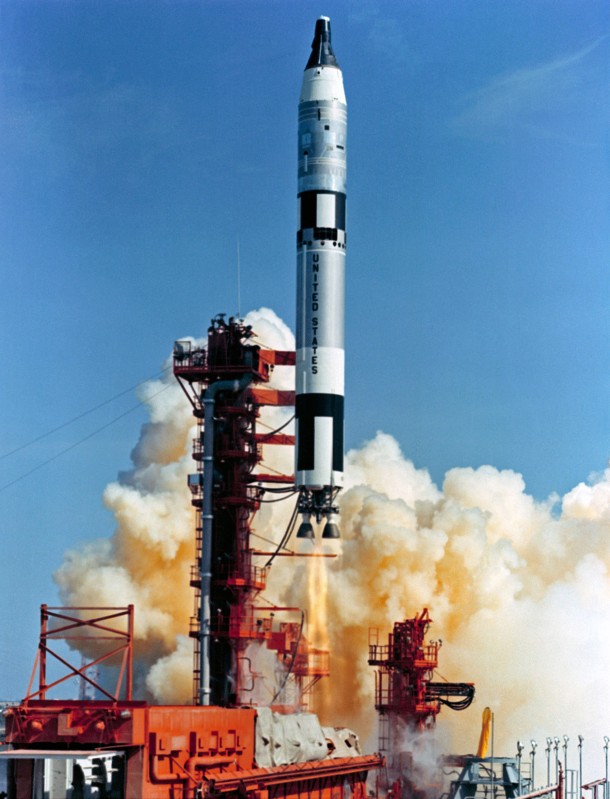
Fifty-one years ago this month, NASA astronauts Leroy Gordon “Gordo” Cooper and Charles M. “Pete” Conrad set a new spaceflight endurance record during the flight of Gemini 5. It was the third of ten (10) missions in the historic Gemini spaceflight series. The motto for the mission was “Eight Days or Bust”.
The purpose of Project Gemini was to develop and flight-prove a myriad of technologies required to get to the Moon. Those technologies included spacecraft power systems, rendezvous and docking, orbital maneuvering, long duration spaceflight and extravehicular activity.
The Gemini spacecraft weighed 8,500 pounds at lift-off and measured 18.6 feet in length. Gemini consisted of a reentry module (RM), an adapter module (AM) and an equipment module (EM).
The crew occupied the RM which also contained navigation, communication, telemetry, electrical and reentry reaction control systems. The AM contained maneuver thrusters and the deboost rocket system. The EM included the spacecraft orbit attitude control thrusters and the fuel cell system. Both the AM and EM were used in orbit only and discarded prior to entry.
Gemini-Titan V (GT-5) lifted-off at 13:59:59 UTC from LC-19 at Cape Canaveral, Florida on Saturday, 21 August 1965. The two-stage Titan II launch vehicle placed Gemini 5 into a 189 nautical mile x 87 nautical mile elliptical orbit.
A primary purpose of the Gemini 5 mission was to stay in orbit at least eight (8) days. This was the minimum time it would take to fly to the Moon, land and return to the Earth. Other goals of the Gemini 5 mission were to test the first fuel cells, deploy and rendezvous with a special rendezvous pod and conduct a variety of medical experiments.
Despite fuel cell problems, electrical system anomalies, reaction control system issues and the cancellation of various experiments, Gemini 5 was able to meet the goal of an 8-day flight. But it wasn’t easy. The last days of the mission were especially demanding since the crew didn’t have much to do. Pete Conrad called his Gemini 5 experience “8 days in a garbage can.”
On Sunday, 29 August 1965, Gemini 5 splashed-down in the Atlantic Ocean at 12:55:13 UTC. Mission elapsed time was 7 days, 22 hours, 55 minutes and 13 seconds. A new spaceflight endurance record.
Gemini 5 was Gordon Cooper’s last spaceflight. Cooper left NASA due to a deteriorating relationship with management. Pete Conrad flew three (3) more times in space. In particular, he commanded the Gemini 11, Apollo 12 and Skylab I missions. Indeed, Conrad’s Apollo 12 experience made him the third man to walk on surface of the Moon.
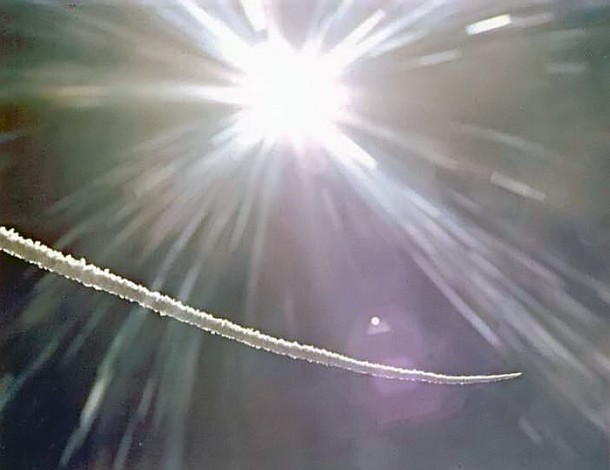
Fifty-three years ago today, NASA chief research pilot Joseph A. Walker flew X-15 Ship No. 3 (S/N 56-6672) to an altitude of 354,200 feet. This flight would mark the highest altitude ever achieved by the famed hypersonic research vehicle.
Carried aloft by NASA’s NB-52A (S/N 52-0003) mothership, Walker’s X-15 was launched over Smith Ranch Dry Lake, Nevada at 17:05:42 UTC. Following drop at around 45,000 feet and Mach 0.82, Walker ignited the X-15’s small, but mighty XLR-99 rocket engine and pulled into a steep vertical climb.
The XLR-99 was run at 100 percent power for 85.8 seconds with burnout occurring around 176,000 feet on the way uphill. Maximum velocity achieved was 3,794 miles per hour which tranlates to Mach 5.58 at the burnout altitude. Following burnout, Walker’s X-15 gained an additional 178,200 feet in altitude as it coasted to apogee.
Joe Walker went over the top at 354,200 feet (67 miles). Although he didn’t have much time for sight-seeing, the Earth’s curvature was strikingly obvious to the pilot as he started downhill from his lofty perch. Walker subsequently endured a hefty 5-g’s of eyeballs-in normal acceleration during the backside dive pull-out. The aircraft was brought to a wings-level attitude at 70,000 feet. Shortly after, Walker greased the landing on Rogers Dry Lake at Edwards Air Force Base, California.
The X-15 maximum altitude flight lasted 11 minutes and 8 seconds from drop to nose wheel stop. In that time, Walker and X-15 Ship 3 covered 305 miles in ground range. The mission was Ship No. 3’s 22nd flight and the 91st of the X-15 Program.
For Joseph Albert Walker, the 22nd of August 1963 marked his 25th and last flight in an X-15 cockpit. The mission qualified him for Astronaut Wings since he had exceeded the 328,000 foot (100 km) FAI/NASA standard set for such a distinction. Ironically, the historic record indicates that Joe Walker never officially received Astronaut Wings for this flight in which the X-15 design altitude was exceeded by over 100,000 feet.
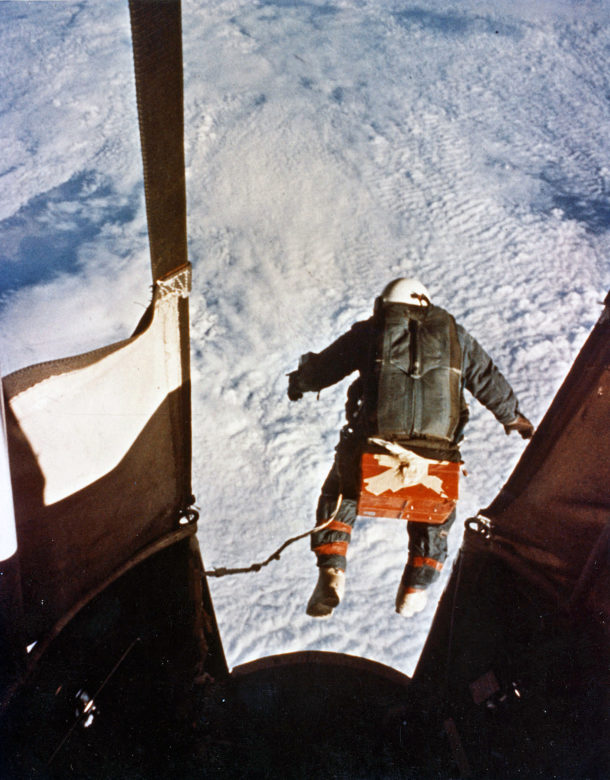
Fifty-six years ago to the day, USAF Captain Joseph W. Kittinger, Jr. successfully completed a daring parachute jump from 102,800 feet (19.5 miles). The historic bailout took place over the Tularosa Basin of New Mexico.
Kittinger’s jump was the final mission of the three-jump Project Excelsior flight research effort which focused on manned testing of the Beaupre Multi-Stage Parachute Parachute (BMSP). The system was being developed to provide USAF pilots with a means of survival from an extreme altitude ejection.
Transport to jump altitude was via a 3-million cubic foot helium balloon. Kittinger rode in an open gondola. He was protected from the harsh environment by an MC-3 partial pressure suit as well as an assortment of heavy cold-weather clothing. Kittinger and his jump wardrobe and flight gear weighed a total of 313 pounds
The Excelsior III mission was launched just north of Alamogordo, New Mexico at 11:29 UTC on Tuesday, 16 August 1960. Ninety-three minutes later, Kittinger’s fragile balloon reached float altitude. At 13:12 UTC, Kittinger stepped out of the gondola and into space. As he did so, he said: “Lord, take care of me now!”
The historic record shows that Joe Kittinger experienced a free-fall that lasted 4 minutes and 36 seconds. During this time, he fell 85,300 feet (16.2 miles). Incredibly, Kittinger reached a maximum free-fall velocity of 614 miles per hour (Mach 0.92) passing through 90,000 feet.
The BMSP worked as advertised. Kittinger entered the cloud deck obscuring his Tularosa Basin landing point at 21,000 feet. Main parachute deployment occurred at 17,500 feet. Total elapsed time from bailout to touchdown was 13 minutes and 45 seconds.
While Joe Kittinger and the Excelsior team focused on flight testing technology critical to the survival of fellow aviators, a byproduct of their efforts were aviation records that stood for over 50 years. Those achievements include: highest parachute jump (102,800 feet), longest free-fall duration (4 minutes 36 seconds – this record still stands), and longest free-fall distance (85,300 feet).
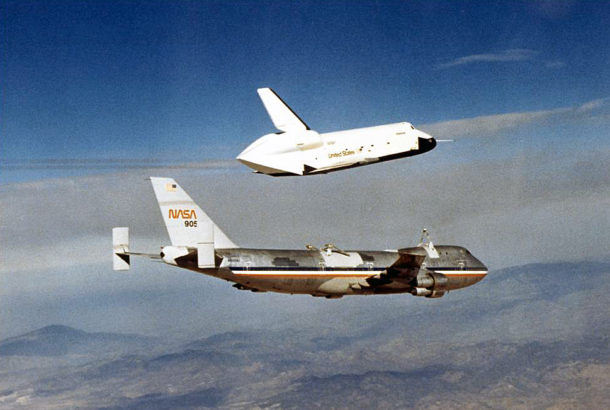
Thirty-nine years ago this week, the Space Shuttle Orbiter Enterprise successfully completed the first free flight of the Approach and Landing Tests (ALT) Program. NASA Astronauts Fred W. Haise, Jr. and Charles G. “Gordon” Fullerton were at the controls of the pathfinder orbiter vehicle (OV-101).
Developers of the Space Shuttle Orbiter faced the challenge of designing a vehicle capable of flight from 17,500 mph (Mach 28) at entry interface (400,000 ft) to 220 mph (Mach 0.3) at landing. Complicating this task was the fact that the Orbiter flew an unpowered, lifting entry that covered a distance of more than 4,400 nm. Once at the landing site, Shuttle pilots had a single opportunity to land the winged ship.
An Orbiter’s approach to the landing field is quite steep compared to that of a commercial airliner. Whereas the glide slope of the latter is around 2-3 degrees, the Orbiter’s flight path during approach is about 22 degrees below the horizon. Falling like a rock is an apt description of its flight state.
The Space Shuttle Approach and Landing Tests (ALT) involved a series of flight tests intended to verify the subsonic airworthiness and handling qualities of the Orbiter. Conducted at Edwards Air Force Base between February and October 1977, the ALT employed a modified Boeing 747 known as the Shuttle Carrier Aircraft (SCA). The Orbiter Enterprise was attached atop the SCA to hitch a ride to altitude.
The Shuttle ALT consisted of a total of thirteen (13) flight tests; five (5) Captive-Inactive (CI) tests, five (5) Captive-Active (CA) tests and three (3) Free Flight (FF) tests. CI testing was aimed at verifying the handling qualities of the SCA-Orbiter combination in flight. There was no crew was onboard the Orbiter for these tests. CA testing focused on preparing for the upcoming free flight series. A crew flew onboard the Orbiter which remained mated to the SCA.
The ALT Free Flights were where the rubber met the road so to speak. The Enterprise and her crew separated from the SCA at altitudes ranging from between 19,000 and 26,000 ft to test the Orbiter in free flight. Landings were made initially on Rogers Dry Lake (Runway 17) and ultimately on Edwards’ 15,000-ft concrete runway (Runway 22).
The Enterprise was flown in two (2) different configurations. The first involved the use of a tailcone fairing which streamlined the base region of the Orbiter. This increased the Orbiter’s lift-to-drag ratio which decreased the vehicle’s rate of descent. It also reduced the level of buffeting experienced by the SCA’s empennage while the Orbiter rode atop the carrier aircraft.
The second Enterprise configuration flown involved removal of the tailcone. This significantly reduced the Orbiter’s lift-to-drag ratio and correspondingly increased the rate of sink. Indeed, the Orbiter’s descent rate without the tailcone was roughly twice as high as that with the tailcone. Removal of the tailcone also markedly increased the buffet loads sustained by the SCA’s empennage.
ALT Free Flight No. 1 took place on Friday, 12 August 1977. With Fitzhugh L. Fulton, Jr. and Thomas C. McMurtry flying the SCA (N905NA), the Enterprise and her crew of Haise and Fullerton was carried to an altitude of 24,100 ft. At a speed of 310 mph in a slight dive, the big glider cleanly separated from the SCA. Just 321 seconds later, the Orbiter touched-down on Rogers Dry Lake at 213 mph.
ALT Free Flights No. 2-5 were successfully conducted over the next several months. Astronauts Joseph H. Engle and Richard H. Truly flew Enterprise on the second and fourth free flights while Haise and Fullerton manned the Orbiter’s cockpit on the third and fifth missions.
Enterprise flew without the tailcone during the last two ALT flights. As expected, the trip downstairs was rapid. Time of descent from 22,400 ft for Free Flight No. 4 was 154 seconds with a landing speed of 230 mph. Free Flight No. 5 took only 121 seconds to descend 19,000 ft and landed at 219 mph.
ALT Free Flight No. 5 was notable in that (1) the Enterprise made its first landing on concrete and (2) a Pilot-Induced Oscillation (PIO) occurred at initial touchdown. For a few tense moments Command Pilot Haise struggled to keep his skittish steed on the ground. Following several disturbing skips and bounces, the Enterprise finally settled down and rolled to a stop.
The Space Shuttle Approach and Landing Tests (ALT) were a necessary prelude to space for the Orbiter. Indeed, the ALT flights represent the first time that NASA’s new winged reentry vehicle took to the air. Having successfully demonstrated the ability to safely land an Orbiter, the next flight in the Space Shuttle Program would be STS-1 in April 1981. Interestingly, that 2-day mission would come to a successful conclusion when the Columbia landed on Rogers Dry Lake back at Edwards Air Force Base, California.
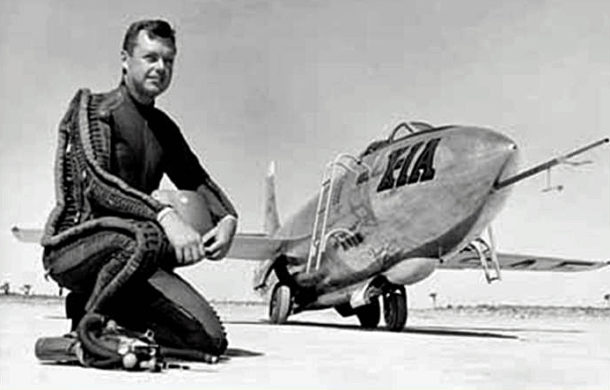
Sixty-two years ago this month, USAF Major Arthur W. “Kit” Murray set a new world altitude record of 90,440 feet in the rocket-powered Bell X-1A. In doing so, Murray reported that he could detect the curvature of the Earth from the apex of his trajectory.
The USAF/Bell X-1A was designed to explore flight beyond Mach 2. The craft measured 35.5 feet in length and had a wing span of 28 feet. Gross take-off weight was 16,500 pounds. Power was provided by an XLR-11 rocket motor which produced a maximum sea level thrust of 6,000 lbs. This powerplant burned 9,200 pounds of propellants (alcohol and liquid oxygen) in about 270 seconds of operation.
Similar to other early rocket-powered X-aircraft such as the Bell XS-1, Douglas D-558-II, Bell X-2 and North American X-15, the X-1A flew two basic types of high performance missions. That is, the bulk of the vehicle’s propulsive energy was directed either in the horizontal or in the vertical. The former was known as the speed mission while the latter was called the altitude mission.
On Saturday, 12 December 1953, USAF Major Charles E. “Chuck” Yeager flew the X-1A (S/N 48-1384) to an unofficial speed record of 1,650 mph (Mach 2.44). Moments after doing so, the X-1A went divergent in all three axes. The aircraft tumbled and gyrated through the sky. Control inputs had no effect. Yeager was in serious trouble. He could not control his aircraft and punching-out was not an option. The X-1A had no ejection seat.
Chuck Yeager took a tremendous physical and emotional beating for more than 70 seconds as the X-1A wildly tumbled. His helmet hit the canopy and cracked it. He struck the control column so hard that it was physically bent. His frantic air-to-ground communications were distinctly those of a man who was convinced that he was about to die.
As the X-1A tumbled, it decelerated and lost altitude. At 33,000 feet, a battered and groggy Yeager found himself in an inverted spin. The aircraft suddenly fell into a normal spin from which Yeager recovered at 25,000 feet over the Tehachapi Mountains situated northwest of Edwards. Somehow, Yeager managed to get himself and the X-1A back home intact.
The culprit in Yeager’s wide ride was the then little-known phenomenon identified as roll inertial coupling. That is, inertial moments produced by gyroscopic and centripetal accelerations overwhelmed aerodynamic control moments and thus caused the aircraft to depart controlled flight. Roll rate was the critical mechanism since it coupled pitch and yaw motion.
In the aftermath of Yeager’s near-death experience in the X-1A, the Air Force ceased flying speed missions with the aircraft. Instead, a series of flights followed in which the goal was to extract maximum altitude performance from the aircraft. USAF Major Arthur W. “Kit” Murray was assigned as the Project Pilot for these missions.
On Thursday, 26 August 1954, Kit Murray took the X-1A (S/N 48-1384) to a maximum altitude of 90,440 feet. This was new FAI record. Murray also ran into the same roll inertial coupling phenomena as Yeager. However, his experience was less tramatic than was Yeager’s. This was partly due to the fact that Murray had the benefit of learning from Yeager’s flight. This allowed him to both anticipate and know how to correct for this flight disturbance.
Murray’s achievement in the X-1A meant that the X-1A held the records for both maximum speed and altitude for manned aircraft. It did so until both records were eclipsed by the Bell X-2 in September of 1956.
Kit Murray was a highly accomplished test pilot who never received the public adulation and notoreity that Chuck Yeager did. He retired from the Air Force in 1960 after serving for 20 years in the military. Murray went on to a very successful career in engineering following his military service. Kit Murray lived to the age of 92 and passed from this earthly scene on Monday, 25 July 2011.





